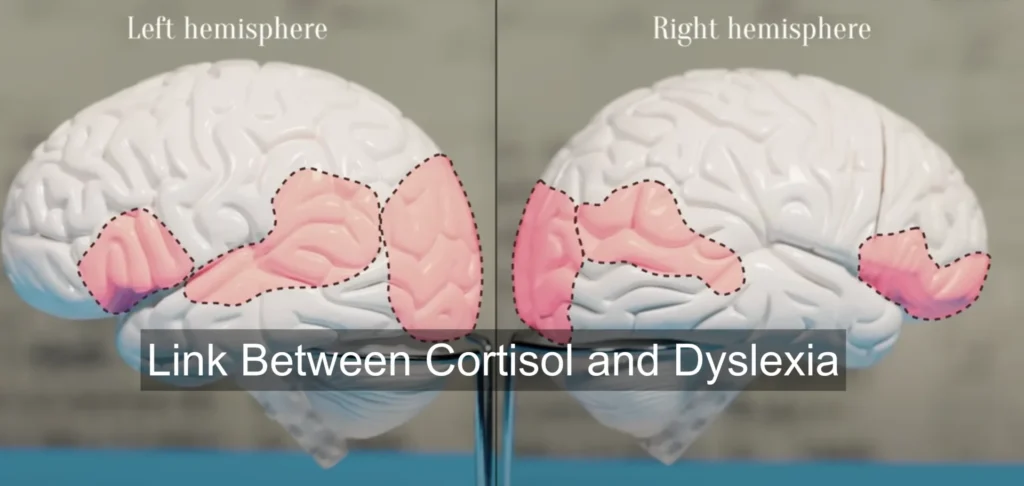There’s no question about it: stress changes the brain. But that’s not only the case for stressed-out adults.
Chronic stress in children can cause more harm than a temporary worry. It can alter their cognitive development, impact reading skills, and increase the risk of dyslexia. Recent research suggests that cortisol, the body’s main stress hormone, plays a key role in this process.
Cortisol and Brain Development

Cortisol helps the body regulate metabolism, inflammation, and memory. However, cortisol levels can stay elevated during times of ongoing stress, which can result in long-term effects on brain function.
- Research from the Harvard Mahoney Neuroscience Institute explains how persistently high cortisol levels can weaken connections to the prefrontal cortex, a crucial region of the brain responsible for executive function and working memory (2014). Prolonged high cortisol levels can cause impairments in memory and learning.
When kids are learning to read, it’s of utmost importance for them to have a working memory. That way, they can hold sounds, letters, and sentence structures in their minds as they progress and add to their knowledge. However, reading fluency and comprehension can suffer when stress disrupts the process.
A study in Pediatrics that researched the effects of poverty on children found that those with higher cortisol levels performed worse in phonological awareness, a key predictor of dyslexia risk (Johnson et al., 2016).
Link Between Cortisol and Dyslexia
According to the Yale Center for Dyslexia and Creativity, dyslexia affects 5% to 20% of the population. The condition is often linked to differences in brain structure and function, and chronic stress can compound those differences.

Neuroscientists who published in the journal Neurology found that excessive cortisol exposure actually disrupts the development of white matter pathways in the brain. Some of these connections are necessary for cognitive performance like language processing (Echouffo-Tcheugui et al, 2018).
- It’s known that children with dyslexia already struggle with phonological processing, but stress can worsen these difficulties.
- A study in Developmental Review found that children with reading difficulties had heightened cortisol responses.
- This only reinforces the idea that stress interferes with learning (Burenkova et al., 2021)
Stress in the Classroom
Classrooms should be safe learning spaces. Unfortunately for some kids, they can be stress-inducing environments. Things like text anxiety, reading aloud, and struggling to keep pace with peers can trigger cortisol spikes in some children. Over time, this repeated exposure to stress can impair the ability to learn and only reinforce learning difficulties.
- Parents and teachers can help struggling students by reducing the stressors from their learning environment.
- They can provide structured reading interventions, encourage breaks, and just foster an overall growth mindset.
- All of these things can lower cortisol levels and improve reading outcomes.
Identification of At-Risk Students
Early intervention is absolutely critical for any student at risk of reading challenges, and dyslexia is no exception. The Tests of Dyslexia (TOD™) provide an evidence-based assessment of dyslexia risks. The results of the evaluations also help identify which kids need support. Research has shown that early screening opens the door to targeted interventions to improve literacy outcomes.
Support Children Facing Reading Challenges

Luckily for all the caring parents and educators, there are proven ways to support kids with dyslexia and other reading challenges. Some techniques include:
- Encourage low-stress reading activities at home.
- Offer positive reinforcement instead of correction.
- Use multisensory reading techniques that engage different learning pathways.
- Advocate for school-based dyslexia screening using tools like the TOD.
Remember, reading should be an opportunity for growth, not a source of stress. Visit WPS to learn more about using assessment tools to help children succeed in school.
Research and Resources:
Tackling Dyslexia at an Early Age. Harvard Mahoney Neuroscience Institute Newsletter. (2014). https://hms.harvard.edu/news-events/publications-archive
Johnson, S. B., Riis, J. L., & Noble, K. G. (2016). State of the Art Review: Poverty and the Developing Brain. Pediatrics. https://pmc.ncbi.nlm.nih.gov/articles/PMC4811314/
Dyslexia FAQ. Yale Center for Dyslexia and Creativity. https://dyslexia.yale.edu/dyslexia/dyslexia-faq/
Echouffo-Tcheugui, J. B., Conner, S. C., Himali, J. J., Maillard, P., DeCarli, C. S., Beiser, A. S., Vasan, R. S., & Seshadri, S. (2018). Circulating cortisol and cognitive and structural brain measures: The Framingham Heart Study. Neurology. https://pmc.ncbi.nlm.nih.gov/articles/PMC6260201/
Burenkova, O., Grigorenko, E., & Naumova, O. (2021). Stress in the Onset and Aggravation of Learning Disabilities. Developmental Review. https://www.researchgate.net/publication/352225283_Stress_in_the_onset_and_aggravation_of_learning_disabilities

